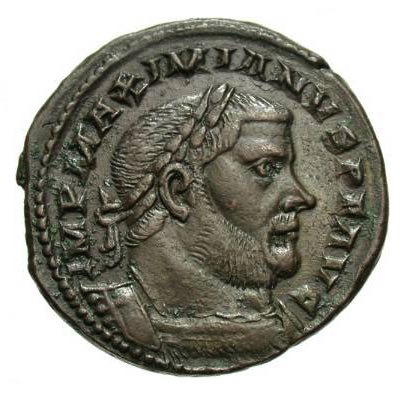

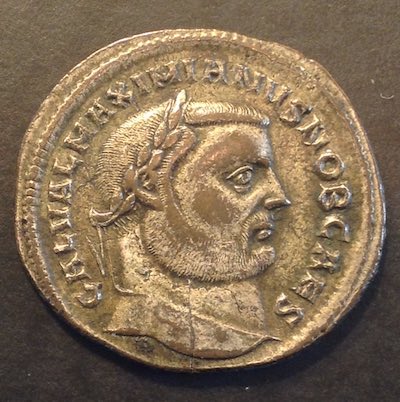
The First Tetrarchy
(To go to those coins, click on the images)
Introduction to Roman coins of the First Tetrarchy:
Diocletian, Maximian, Constantius, and Galerius, 284-305
 |
|
| Maximian, western Augustus | Diocletian, eastern Augustus |
 |
 |
| Constantius, western Caesar | Galerius, eastern Caesar |
|
The First Tetrarchy |
|
Diocletian became the Roman emperor ("Augustus") in the east in 284 CE and ruled until his abdication in 305. In 285 he added Maximian as Caesar and promoted him to co-Augustus in 286. In 293 he added two Caesars, Constantius and Galerius, making four simultaneous rulers, that is, a "tetrarchy."
The "First Tetrarchy," March 1, 293 - May 5, 305:
• Maximian (in the west) and Diocletian (in the east) Augustus
• Constantius (in the west) and Galerius (in the east) Caesar
Their portraits on large (28 mm) folles are to the right.
When Diocletian came to power there was only one coin denomination commonly circulating--the "aurelianus" (a.k.a. "antoninianus," also affectionately known as an "ant"). It had been introduced in the coin reform of Aurelian in 274. In 294 production of the aurelianus was discontinued and the common large "follis" (or "nummus") was introduced.
(Links are to paragraphs further down this page. If you want to skip this overview, here are links to advanced pages.)
Events. Numerous events affected the coinage. During his reign Diocletian
• added a co-Augustus, Maximian, April 1, 286. (Reverse legends on Diocletian's aureliani that ended "AVG" changed to end "AVGG" with two G's indicating two emperors.) Ancient sources say Maximian was first made Caesar in the summer of 285, but there are no coins of Maximian as Caesar.
• added two Caesars in 293, Constantius and Galerius, making the "First Tetrarchy" ("four rulers") (Aureliani were minted for the Caesars.)
• reformed the coinage, adding three new denominations (taking a year or more c. 294 to make all the changes.)
the "nummus" (= "follis") (Minted for all four rulers, it is commonly called a "follis" now, but it was likely called a "nummus" = "coin" in antiquity)
the "post-reform radiate" a.k.a. "radiate fraction" (Minted for all four rulers, but only at half the mints.)
the good-silver "argenteus" (Minted for all four rulers. Now rare, but usually in high grade. It did not circulate much.)
production of aureliani ceased.
earlier he had regularized the weights of the gold coins to 60 to the pound (Gold of the period is all rare and extremely expensive.)
• issued two edicts on coinage. The Currency Edict of September 1, 301, doubled the nominal values of the follis, argenteus, and possibly other denominations. The second, the more famous Edict on Maximum Prices, promulgated later that same year, gives the maximum permissible prices of 1200 items. The new SACRA MONETA follis type was issued.
• voluntarily retired in 305. At the same time Maximian was forced to also retire, the Caesars were promoted to Augusti, and two new Caesars (Severus II and Maximinus II) were appointed, thus creating the "Second Tetrarchy." Coins were minted for all six rulers, including retirement coins for Diocletian and Maximian.
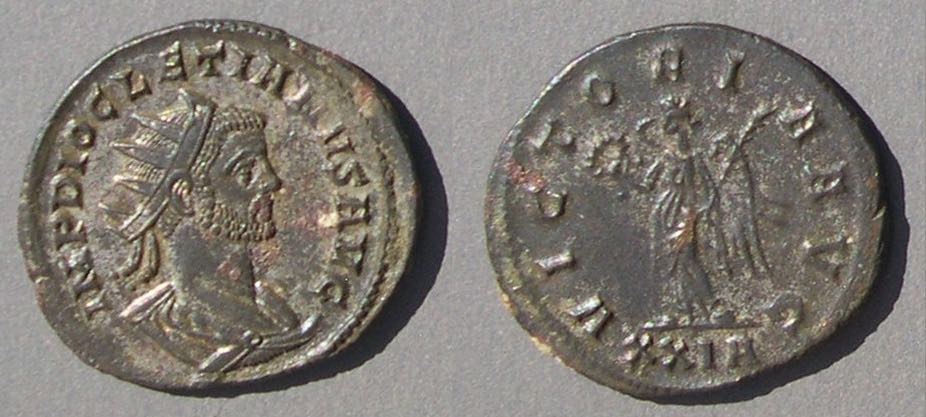 The first denomination--the aurelianus. The first coins of Diocletian continued the denomination of previous emperors.
The first denomination--the aurelianus. The first coins of Diocletian continued the denomination of previous emperors.
Diocletian. A 22 mm (1 mm larger than a US nickel) aurelianus with obverse legend IMP DIOCLETIANVS AVG (IMPerator DIOCLETIANVS AVGustus) and emperor's bust right with a radiate crown. The reverse celebrates Victory with legend VICTORIA AVG. This coin was struck at the Rome mint c. 285. RIC Rome 183. The "XXI" in exergue (below the ground line on the reverse) is a symbol for this denomination which was introduced by Aurelian in his coin reform of 274. The "A" in "XXIA" indicates it was made in the first workshop of the mint.
This coin was struck before Maximian was made co-Augustus. We can tell because the reverse legend ends with one G, "AVG". After Maximian was elevated similar legends end in plural, "AVGG", with two G's.
(For many more examples from each of the four rulers, see this page. For rare pre-reform fractions, see below).
Note about this page: "RIC" abbreviates Roman Imperial Coinage, volume V, part 2 (1933) for aureliani and volume VI (1973) for post-reform coins. Many varieties have been discovered since these books were published, but there is no easy way know more than is in them.
 The follis. Diocletian's famous coin reform introduced the follis (= nummus) denomination. It is common and here is its most common type: "GENIO POPVLI ROMANI".
The follis. Diocletian's famous coin reform introduced the follis (= nummus) denomination. It is common and here is its most common type: "GENIO POPVLI ROMANI".
Diocletian. 27-26 mm. 9.23 grams. This coin is large--3 mm larger than a US quarter. (Image sizes are proportional to actual sizes.)
IMP DIOCLETIANVS AVG
The reverse is the Genius (spirit) of the Roman people standing left, holding a patera and cornucopia.
GENIO POPVLI ROMANI
with mintmark IITR for the Trier mint.
RIC VI Trier 524a. Struck c. 302-3. (Pre-reform aureliani are in RIC V, part II, and post-reform coins are in RIC VI.)
This type was issued in great numbers at a dozen mints all across the empire. Issued for all four tetrarchs, it continued later for Severus II, Maximinus II, and Constantine. There is more about the follis denomination below (and much more about this type on pages about GENIO POPVLI ROMANI folles).
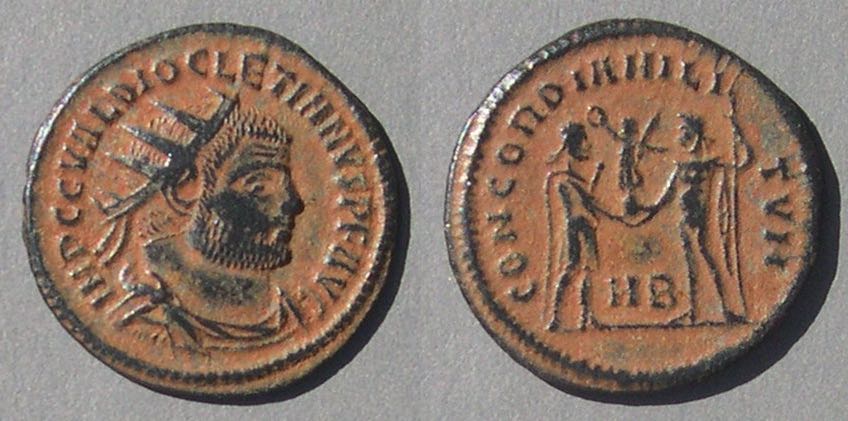
Post-reform radiate. Here is a "post-reform radiate". This is not an elegant name, but we don't know what the Romans called it, but it is "post-reform" and it is "radiate." RIC calls it a "radiate fraction." It looks very much like the pre-reform aurelianus and even dealers often do not distinguish them properly. (For more about them and how to distinguish them, see below.)
Diocletian. 21 mm. (The size of a US nickel.) 2.78 grams.
Struck 295-6, post-reform.
IMP C C VAL DIOCLETIANVS PF AVG
(IMPerator Caesar Caius VALerius DIOCLETIANVS Pius Felix AVGustus)
CONCORDIA MILITVM, emperor on the left receiving Victory on a globe from Jupiter on the right. HB between them with "H" for the Heraclea mint and "B" for the second workshop.
RIC VI Heraclea 13.
(See this page for much more about the radiate-fraction denomination.)
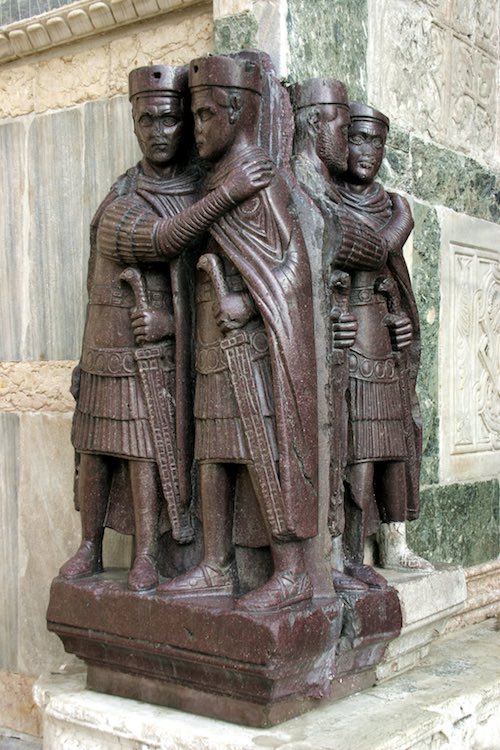 Comment for collectors. Roman coins of the four emperors of the First Tetrarchy are very collectable. They are common and easy to obtain in pleasing condition. There is enough--but not too much--variety in the types to provide a nice collecting challenge, and the history of the period is fascinating.
Comment for collectors. Roman coins of the four emperors of the First Tetrarchy are very collectable. They are common and easy to obtain in pleasing condition. There is enough--but not too much--variety in the types to provide a nice collecting challenge, and the history of the period is fascinating.
Three denominations are common:
• the (pre-reform) "aurelianus" or "antoninianus" radiate denomination issued before Diocletian's coin reform of 294 (the first coin, above right),
• the large (post-reform) "follis" (second) and
• the "post-reform radiate" (third). (There are also other denominations, all quite rare.)
All of these three denominations above can be found for all four rulers. Picking one type (perhaps even from a single mint) would make an interesting matched set for a collecting mini-theme.
To the right is a photo from Wikipedia by Nino Babrari of a porphory statue of the four tetrarchs, now at St. Marks in Venice.
The first change. It didn't take long for Diocletian to decide the empire was too large to rule alone. He elevated Maximianus (= Maximian) to Caesar in summer 285 and then to co-Augustus, April 1, 286. Maximian has no coins as Caesar.
Each augustus was associated with a protecting deity--Diocletian with Jupiter (Jove) and Maximian with Hercules. The emperor we call Maximianus is sometimes called "Maximianus Herculius" to emphasize the distinction between him and Galerius who also had MAXIMIANVS in his name and on many of his coins. (The reason for this is discussed on its own page.) Maximian was added to the coinage and reverse legends that had ended "AVG" changed to ending "AVGG" where the second G indicates two Augusti, as on the next coin.
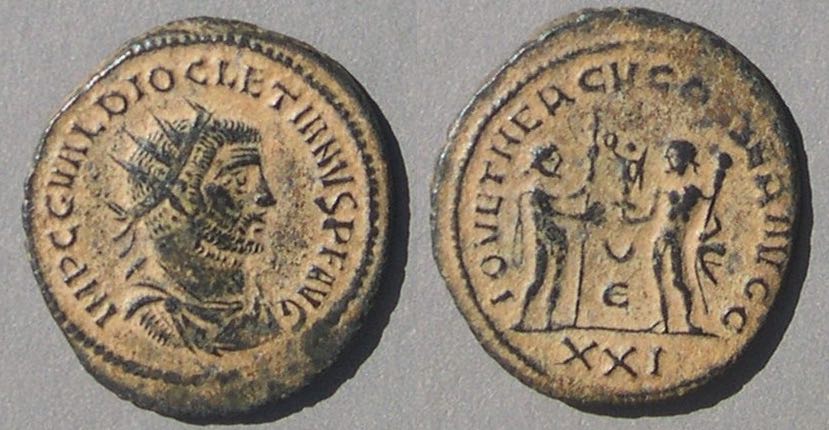 Diocletian. Aurelianus (note the "XXI" in exergue)
Diocletian. Aurelianus (note the "XXI" in exergue)
22-21 mm. 3.55 grams.
IOV ET HERCV CONSER AVGG
Jupiter and Hercules, protectors of the emperors.
Hercules on right with club, presenting Victory to Jupiter with long staff on left
XXI in exergue.
RIC Antioch 323c, "c. 293"
After Diocletian took Maximian as co-ruler, reverse legends that ended "AVG" change to ending "AVGG", with 2 G's like this one.
The second change: The First Tetrarchy. The First Tetrarchy ("four rulers") began in March 293 when the augusti Diocletian and Maximian chose Galerius and Constantius to become co-rulers with the lesser title Caesar. It ended May 1, 305 with the retirements of Diocletian and Maximian, the promotion of Galerius and Constantius to Augusti, and the inauguration of two new Caesars, Severus II and Maximinus II, which began the short-lived "Second Tetrarchy." By the way, the term "tetrarchy" was coined in the late 19th century by German scholars--it was not used in antiquity.
When Constantius and Galerius became Caesars in 293 the aurelianus was still the only commonly circulating denomination. This denomination is scarce for the two Caesars because Diocletian's coin reform of 294 discontinued it, so for them it was only issued for about one year.
 Constantius as Caesar
Constantius as Caesar
22-21 mm. 3.75 grams.
FL VAL CONSTANTIVS NOB C
(FLavius VALerius CONSTANTIVS NOBle Caesar)
CONCORDIA MILITVM
Jupiter on right presenting Victory on globe to emperor on left
A in middle field below, XXI • in exergue
RIC V.II 672A (Variety with A, not E) Cyzicus page 302.
Sear IV 13982
This is by far the most common reverse type of aurelianus for Constantius. However, it is not common for Galerius.
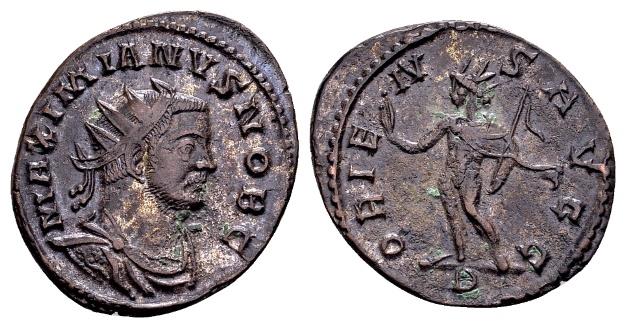 Galerius as Caesar
Galerius as CaesarThe next change: The Coin Reform of 294. When Diocletian came to power in AD 284 the coinage system had only very common aureliani and rare gold coins of irregular weights which had to be weighed for each transaction. The aureliani had at most 4-5% silver, some of which was in a thin surface-silvering which soon wore off and left the coins looking like copper, which they mostly were. The reform process took more than a year and had these results:
• Copper/base metal: the previous aurelianus was replaced by two denominations, the much larger follis (also with 4-5% silver in the east, but possibly less silver in the west) and the post-reform radiate of the same size and general appearance as the aurelianus, but with no silver and therefore much less intrinsic value. It was issued only in the east.
• Silver: There had been none and the new "argenteus" of good silver was introduced (The word simply means "of silver").
• Gold: There had been infrequent issues of gold of irregular weights. The first coinage reform of Diocletian (well before 294) was to make the weights regular at 60 to the pound and to issued more of them. Nevertheless, they are very expensive today. We now usually call the new denomination an aureus, but ancient sources called it a solidus, which is the name we use for the lighter gold piece introduced under Constantine. This page does not consider gold further.
• Mints: Pre-reform: Coins are attributed to mints by style and a few cryptic control marks, but attribution to mints really requires reference to scholarly works like RIC. Post-reform: Folles are attributed to mints by clear abbreviations of the names of the mints in exergue (e.g. TR for Treveri = Trier, LVG for Lugdunum = Lyons, and ANT for Antioch).
The Follis. Folles of all four tetrarchs are common. This new denomination is commonly called a "follis," but was likely called a "nummus" ("coin") in antiquity. Pieces were originally surface-silvered, but most have little or no surface-silvering remaining. There is evidence that the first nummi were minted at Heraclea shortly before the Caesars were elevated in 293 and the other mints followed over time. The reform did not happen at the same time everywhere.
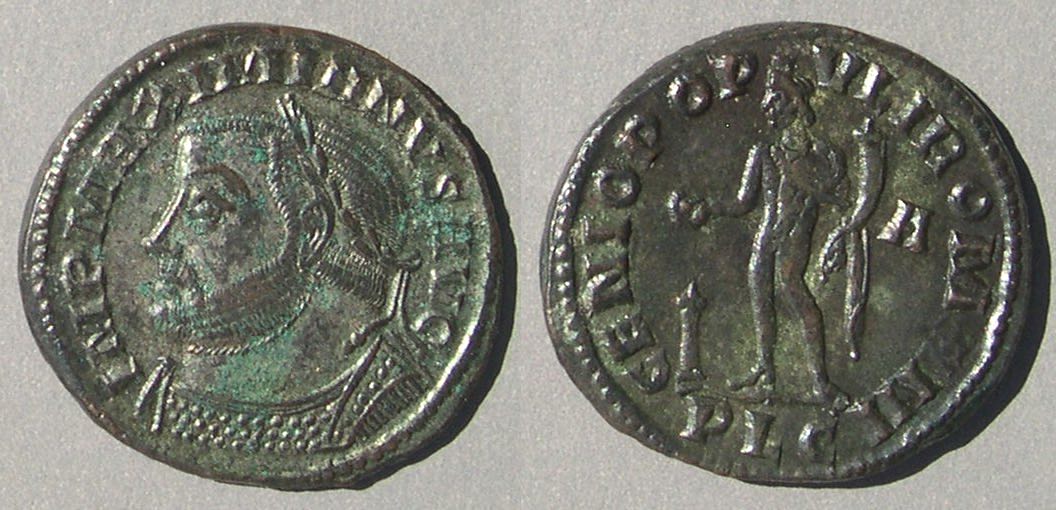
Maximian
28 mm. 10.16 grams. Traces of surface-silvering.
Bust left, which would be rare from other mints, but which is typical from Lugdunum. Also, Lugdunum has a small flaming altar left of Genius which is rarely found from other mints.
IMP MAXIMIANVS AVG
A in right field
PLG = Lugdunum in exergue
RIC VI Lugdunum 113b, "c. 301-303".
Most folles are of this GENIO POPVLI ROMANI type and they are issued for the four rulers from each of a dozen mints. There are nine other reverse types of folles, each not rare, that together amount to fewer coins than the GENIO POPVLI ROMANI type. However, if you include mintmarks and unusual bust types, there are very many varieties of this GENIO POPVLI ROMANI type, some of which are especially desirable and very valuable. The premium for the next type is probably a factor of two because of the unusual bust type.
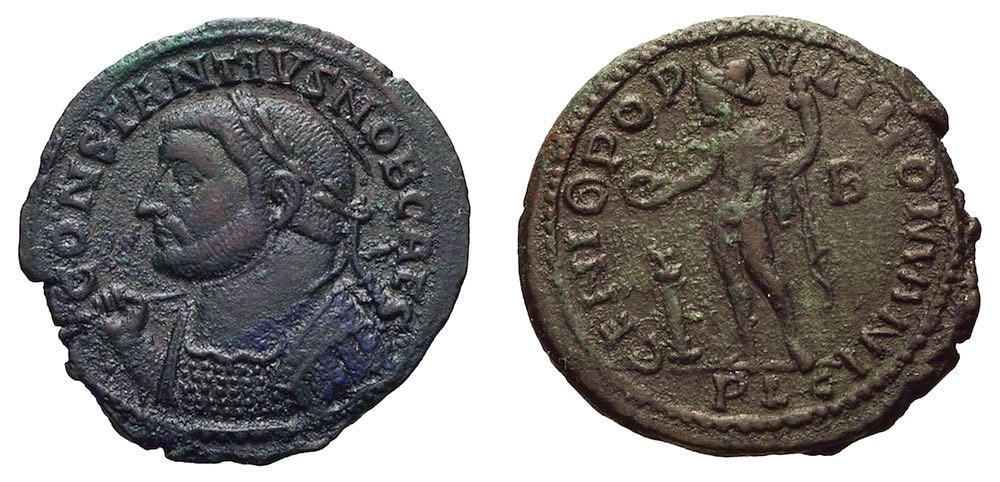
Constantius, as Caesar.
29-28 mm. 10.65 grams.
Again, this one has the common GENIO POPVLI ROMANI reverse type and the small flaming altar in the left field found at Lugdunum. Also, only Lugdunum usually has left-facing busts. However, this bust is unusual, even at Lugdunum, because the emperor has his right hand visible holding a scepter across his far shoulder.
RIC Lyons 144a "c. 301-303."
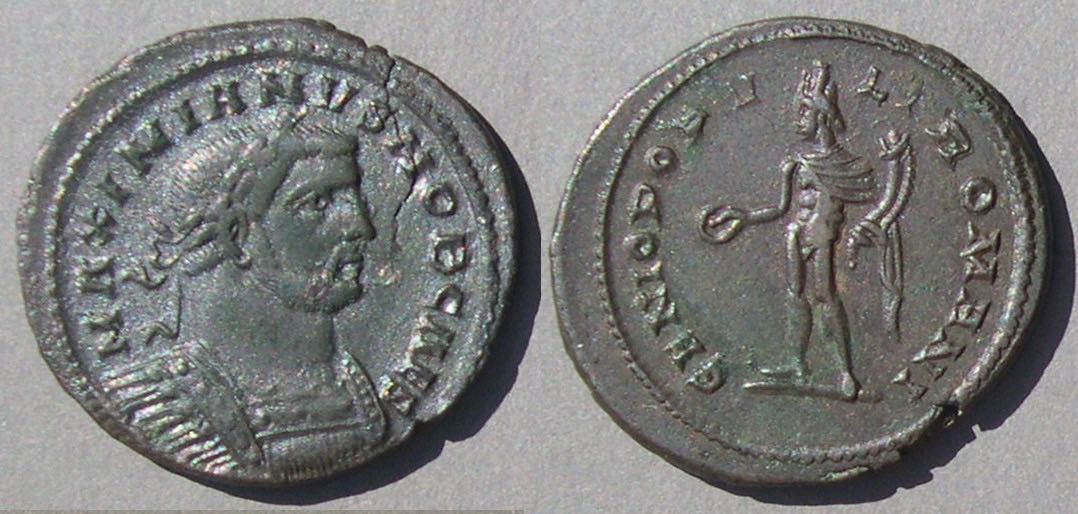 Galerius, as Caesar.
Galerius, as Caesar.
28-26 mm. 8.23 grams.
MAXIMIANVS NOB CAES
In spite of the legend including "MAXIMIANVS" this coin is of Galerius as Caesar. Maximian did not issue coins as Caesar.
The reverse has no mintmark in exergue, which is typical of the London mint. Coins from London carry a small premium.
RIC London 15, c. 300 onward.
 Galerius as Augustus (305-311)
Galerius as Augustus (305-311)About Diocletian. Here are some distinguishing facts about Diocletian. He...
• became Augustus in the east in November 284 by acclamation of the army (after Numerian was found dead on the return trip from victories in Mesopotamia). (Carinus was Augustus in the rest of the empire.)
• became sole emperor while losing a battle (spring 285) (The emperor Carinus was assassinated by one of his own men even as the battle against Diocletian appeared won. Diocletian was left to claim the throne.)
• voluntarily promoted to imperial power a man who was not a relative. (Maximian was made Caesar in the summer of 285 and Augustus April 1, 286. Diocletian retained the East and made Maximian ruler in the West.)
• drastically reorganized the civil government and military by subdividing provinces and military commands. Thus each governor and general was in control of fewer resources--and less able to revolt.
• voluntarily decided to create two more rulers, also not his relatives (Caesars, with responsibility for their own regions of the empire, March 293) [Constantius and Galerius became Caesars in the West and East, respectively, each with about half of the territory]
• completely reformed the coinage system (c. 294)
created new base-metal denominations, the large follis and the post-reform radiate
created a new silver denomination, the argenteus (good-silver coins had not been minted for many decades)
had earlier regularized the gold content of the aureus (This page does not discuss gold coins).
had mints identify themselves on their coins.
• promulgated in 301 two related edicts--his "Currency Edict" (doubling the nominal value of some denominations) and the "Edict on Maximum Prices" to dictate prices for a wide range of goods following a period of high inflation (As modern economics would tell us, it didn't work).
• chose to (was not "forced to") retire (in 305).
• had unprecedented coin types that celebrated his retirement (and that of Maximian, who retired simultaneously, but only temporarily. In 306 Maximian's son Maxentius usurped power in Rome and Maximian soon joined him as Augustus)
Retirement issues. When Diocletian and Maximian retired in 305 each received the new title "Senior Augustus" and had coins issued in his honor.
 Diocletian, retirement issue.
Diocletian, retirement issue.
Follis. 28 mm.
DN DIOCLETIANO PF S AVG, where the "S" is for "Senior" Augustus.
Emperor in imperial mantle right holding mappa in his right hand.
QVIES AVGVSTORM, Quies (= rest/repose/retirement) standing left holding branch down and vertical long scepter.
S A (control marks of unknown meaning)
PTR in exergue, for Trier.
RIC Trier 699. "c. spring 307."
(For much more about retirement issues, see my page on retirement issues.)
The Second Tetrarchy. On May 1, 305, Diocletian and Maximian retired. The Caesars Constantius I and Galerius became the new Augusti. The title on their coins changed from Caesar to Augustus. New Caesars, Severus II and Maximinus II, were chosen (with the strong influence of Galerius).
The "Second Tetrarchy," May 305 - July 306:
• Constantius (western) and Galerius (eastern) Augustus
• Severus II (western) and Maximinus II (eastern) Caesar
• Diocletian and Maximian retired "senior" augusti
Coins for all six rulers were issued. The coins for the retired augusti are discussed on my page,"Abdication coins of Roman emperors Diocletian and Maximian."
Coins of the Second Tetrarchy have their own page.
The "Second Tetrarchy" only lasted until July 306 when the western Augustus Constantius took ill and died. Constantine was then promoted by the army (surely prearranged by Constantius) without the advice and consent of the other rulers. The orderly system that had created the Second Tetrarchy lasted only a year and three months. In short summary, after Constantius died in July 306
• Constantine was immediately acclamed emperor by the army of Constantius (surely he prearranged it)
• Severus II, Caesar, was elevated to Augustus in the west (as expected in the tetrarchal system) by Galerius (who was the remaining, eastern, Augustus)
• Maxentius, son of Maximian, seized power in Rome in October when Severus II was in the north
• Maximian came out of retirement to join him in November,
• both Maxentius (early 307?) and Constantine (July 307) took the title Augustus, and
• Severus II was killed (summer 307) after failing to retake his territory which included the city of Rome.
Each of these events is reflected in the coinage. The story of what happened after the Second Tetrarchy is complicated and discussed at the FIL AVG page.
Collectors' Themes: One coin of each ruler in the First Tetrarchy would require four coins, one each of Diocletian and Maximian as Augusti and Constantius and Galerius as Caesars. Four matching folles would make an attractive and complete mini-theme. The second tetrarchy would have coins of Constantius and Galerius, but now as Augusti for the second tetrarchy, and Severus II and Maximinus II as Caesars. So, another four folles could represent the Second Tetrarchy. In 306 the tetrarchal system broke down and a collection could be continued with coins of Constantine as Caesar, Severus II as Augustus, and Maxentius.
A collection might concentrate on one denomination, say, aureliani or folles. Aureliani are common for Diocletian and Maximian, and available, but much less common for Constantius and Galerius, because it was minted for them for only about a year before the coin reform eliminated that denomination. Here is a page on aureliani. Folles are common for all four rulers. Here are pages on GENIO POPVLI ROMANI folles. Here is a page on SACRA MONETA folles.
There are 14 mints that issued coins in this time period. A collector might specialize in a particular mint. Some English collectors specialize in London mint coins. Trier issued the most expressive portraits and some German collectors emphasize Trier. Rome is an obvious possibility.
Other denominations.
• The new silver argenteus (next).
• Rare fractions issued throughout the period 290-318, mostly from Trier.
• Very rare AE of uncertain denominations (including one sometimes called an as).
• The "quarter-follis" of c. 305-306.
Diocletian's new silver denomination, the argenteus: Prior to the reform there had not been any good-silver coins for many decades. The reform introduced the argenteus. Some, but not the initial issues, are boldly labeled "XCVI" for 96, that is, 96 coins to the Roman pound of silver. In weight, size, and quality, argentei are much like the late denarii of Nero (those struck AD 64-68) which were also struck at 96 to the pound. Ideally, they weigh about 3.3 grams, but the Sisak hoard weight distribution [p. 32] is quite broad, with 10% as low as 2.6 grams.
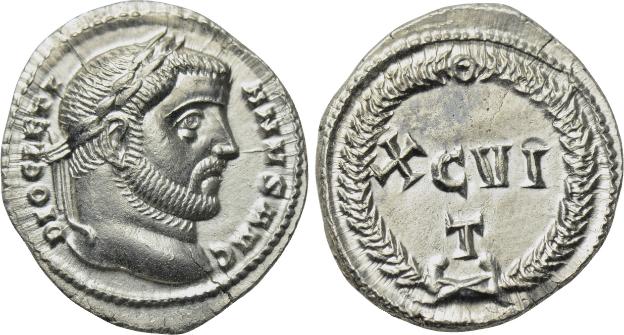
An argenteus of Diocletian. from Ticinum
20-19 mm. 3.30 grams.
DIOCLETI-ANVS AVG
XCVI over T in wreath.
T on the reverse abbreviates the mint, Ticinum.
RIC VI Ticinum 20a, "c. 300".
The portrait is in high relief which is common on argentei, but not seen on the previous aureliani nor the accompanying folles and radiates.
Denominations. It is impossible for governments to fix the relative values of copper, silver, and gold. Market forces always make one or another overvalued relative to the others. Gresham's Laws says "Bad money drives out good" which means that when there are good coins and bad coins adding up to the same value, people will keep the good ones and spend the bad ones (Just as you might spend a beat-up dollar bill before spending a crisp new one). The argenteus denomination had too much silver compared to its nominal value expressed in folles, so it was saved and not spent. Folles were spent, but argentei were not. Therefore, argentei played little role in the monetary system and were discontinued not long after 305. [A page on the relative values of the denominations will appear soon.]
(For much more about the argenteus denomination, go to my page on the argenteus denomination.)
Fractions: Some rare small copper coins ("fractions") were issued at Trier on occasions celebrating vows of the emperors.
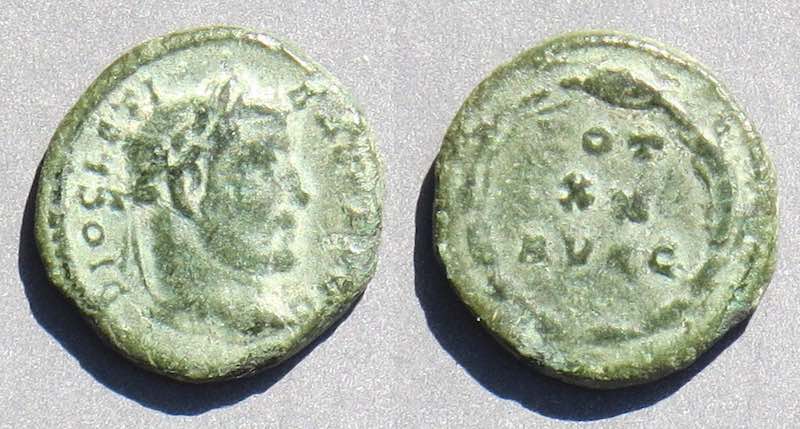 Diocletian, AD 284-305
Diocletian, AD 284-305
14 mm. 2.00 grams. The small "1/8 follis" denomination.
DIOCLETI-ANVS AVG
VOT/XX/AVGG in wreath.
RIC VI Trier 610a.
Zschucke 4.2
Struck c. September 303 [RIC and Zschucke agree]
for the festival occasion celebrating vows for twenty years. (I have my doubts that this date is right. I would date it to the celebation for vows for 10 years paid (soluta) and vows for 20 years taken (suscepta), i.e. c. 294. See my pages on vota coins.)
Another unusual denomination. Most rulers after c. 250 issued a few rare coins of unusual small denominations. We don't know the ancient names of the denominations or why they were issued. They are so rare today that surely they played little role in the monetary system, but they did circulate, as shown by the fact that they are usually quite worn. But, for collectors, they are both rare and clearly unusual, so they tend to be expensive.
![]() Diocletian.
Diocletian.
22 mm. 4.12 grams.
Laureate, so it cannot be an aurelianus.
Thought to be a pre-reform sestertius (formerly called an as or dupondius).
IMP DIOCLETIANVS AVG
IOVI CONSERVATORI Jupiter standing left with thunderbolt and long staff.
RIC V.II 202 "R3." Rome mint.
There are smaller denominations, too. One very rare type is often called a "denarius," but we don't actually know what it was called.
Still another denomination. At the turn of the Second Tetrarchy c. 305 the Siscia mint (in modern Croatia) issued an usual denomination we now call a "quarter follis" (or, sometimes, a "denarius," with little justification). Why this was minted at only the one mint is unknown.
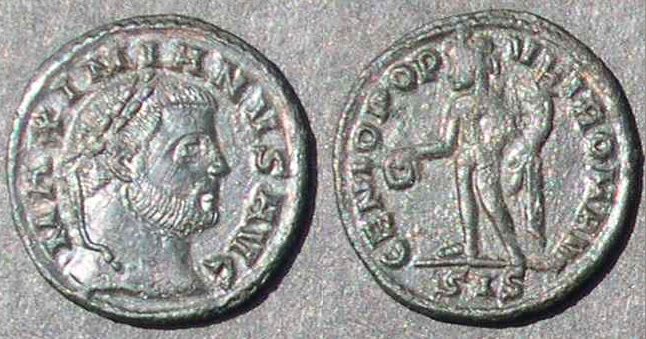 Galerius
Galerius
19 mm (small compared to a 27 mm follis). 2.29 grams (about 1/4 the weight of a follis). We don't know the ancient name and often call it a "quarter follis."
MAXIMIANVS AVG (Nevertheless, this is a coin of Galerius, as is confirmed by the portrait and other coins in the same issue.)
The common GENIO POPVLI ROMANI type, but on a much smaller flan.
SIS in exergue, for Siscia, the only mint to issue this denomination.
RIC VI Siscia 169b. c. 305-6 and "R2" ("very rare") then, but much more common now. Since then the Iron Curtain fell and released many coins onto the market.
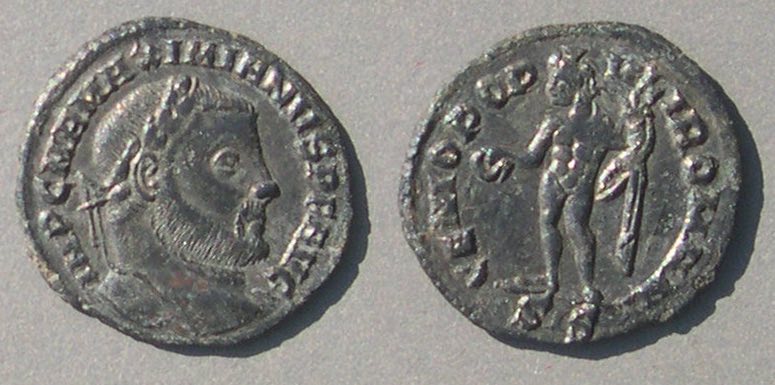 Maximian.
Maximian.
19-18 mm. 2.25 grams.
IMP C M A MAXIMIANVS PF AVG
The full name of Maximian was
Marcus Aurelius Valerius Maximianus. The "M A" in the legend makes it certain this coin is of Maximian and not Galerius. Also, since Maximian has this legend, we attribute the previous coin to Galerius.
RIC VI Siscia 146 "R2," but really much more common than that.
More about the common denominations.
• How to distinguish the aurelianus and the post-reform radiate (next)
• Other rulers on folles
• Other types on folles
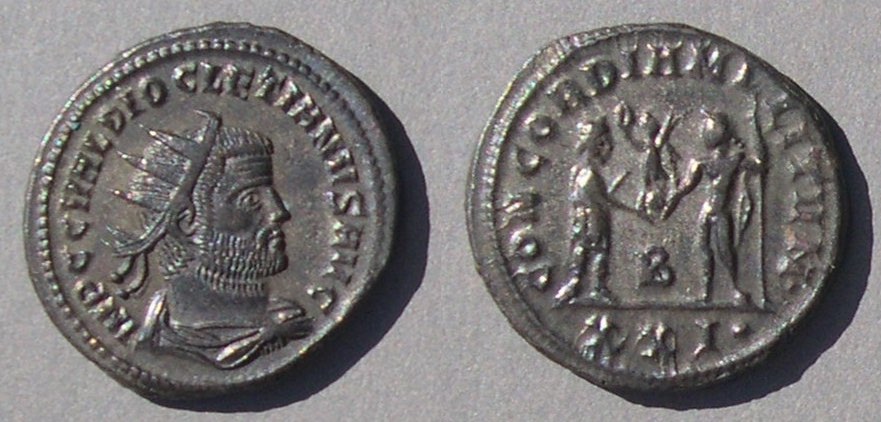 Diocletian. 22 mm. 4.99 grams.
Diocletian. 22 mm. 4.99 grams. Note that the previous coin shows signs of silvering (so, it must be an aurelianus) and this one does not. Also, this one has a larger head.
Note that the previous coin shows signs of silvering (so, it must be an aurelianus) and this one does not. Also, this one has a larger head.The key differences are:
• The old aurelianus (a.k.a. antoninianus) had close to 3-5% total silver (including its thin surface-silvering) but the new similar-sized post-reform radiate had no intentional silver, either in its interior or on its surface.
• The aurelianus had, therefore, more intrinsic value than this new lower denomination (This makes little difference to modern collectors, but the ancient Romans cared about intrinsic value and the small amount of added silver made a big difference because silver was worth, by weight, 80 times as much as copper.)
• The aurelianus often has some remaining surface-silvering and this radiate denomination never does.
• The aurelianus often has "XXI" in exergue (showing the copper to silver ratio is 20 to 1) and the new radiate denomination never does.
• The great majority of post-reform radiates have this reverse legend, CONCORDIA MILITVM, which confusingly, is also on some aureliani (however, usually with "XXI" in exergue).
• Stylistically, the aurelianus has smaller heads with longer necks, whereas the post-reform radiates have larger heads with shorter necks and the coins have rounder flans. However, these are guidelines, not firm rules.
(For many more examples, see this page on radiate fractions.)
Other follis types. A majority of folles under the First Tetrarchy have the GENIO POPVLI ROMANI reverse type, but many do not. Diocletian's reform was not a complete success as proved by the inflation which prompted the currency edict of September 1, 301, which doubled the nominal value of the follis and possibly other denominations. Shortly thereafter the "Edict on Maximum Prices" gave maximium permissible prices for 1200 items. (Very unfortunately, the maximum prices are given in "common denarii," a money of account, as opposed to a coin denomination. The value in common denarii of each of the coin denominations is not clear, although many scholars have published evidence supporting their opinions.) The second-most-common type, next, insists on the importance of respecting the value of the new denomination after Diocletian issued his edicts.

Diocletian
Follis. 27 mm. 10.05 grams. Silvered.
SACR MONET AVGG ET CAES NOSTR
"Sacred mint/money of our Augusti and Caesars"
Moneta holding a balance with the fingers pinching it in the method used to prove that there is no cheating because neither side is being unduly weighted.
RIC VI Aquileia 35a. "c. 302-303."
According to Melville Jones (Dictionary of Ancient Roman Coins), in the early empire the word "moneta" means "mint," not "money" or "coin." At first "Moneta" was an alternative name of the Goddess Juno and in the Republic the mint was near the temple of Juno Moneta. Later the term "moneta" also means a mintage, or even actual coins. Therefore, I think, this type is saying "This denomination of coin (i.e. the follis) and its proclaimed value must be regarded as sacred," i.e. "Don't mess with prices!"
(For much more about SACRA MONETA folles, see this page.)
There are many types on aureliani of the First Tetrarchy. Diocletian has many that refer to Jupiter and some to Hercules. Maximian has many that refer to Hercules and some to Jupiter. However, on folles each has only one type which makes reference to his own deity and that type was issued only at Alexandria.
![]() Diocletian
Diocletian
Follis. Silvered. 27 mm. 9.46 grams.
IMP C DIOCLETIANVS PF AVG
Laureate head right
IOVI CO-NS CAES
Jupiter standing left holding Victory on globe and long staff, with cloak over his left shoulder.
ALE in exergue.
RIC VI Alexandria 41 "c. 304-5"
This IOVI type was also issued for his Caesar, Galerius. The reverse is more appropriate for a Caesar than for Diocletian as Augustus.
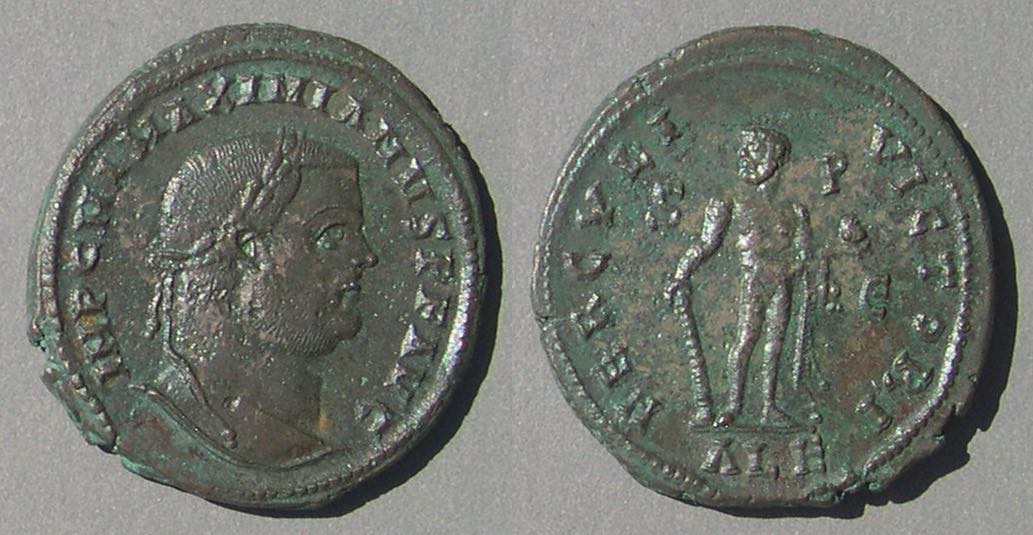 Maximian
MaximianThis HERCVLI type was also issued for his Caesar Constantius.
FORTVNA. Among the other follis types are "FORTVNA" types that refer to hopes for a safe return from foreign adventures.

Diocletian
Follis. 28-27 mm. 7.99 grams.
FORTVNAE REDVCI AVGG NN
Fortuna seated left on stool, holding a rudder and cornucopia.
RIC Trier 230a, "c.298-9".
Fortuna was the Italian goddess of chance or luck in the sense of good fortune, bad fortune, and the future. She contributes to steering the course of events, hence the rudder. Good fortune brings abundance, hence the cornucopia. Our terms "fortunate" and "fortune teller" derive from Fortuna. One aspect pertained to fortune in battle. Fortuna REDVX is her aspect relating to a safe return from trips. The reverse legends on this issue under the tetrarchy are in plural AVGG NN = "of our Augusti," which emphasizes the unity of the college of emperors. Some were away and would hopefully return safely.
(For much more about Fortuna types, see a page on FORTVNA types.)
Other follis types. The follis became the main denomination for the next decades, however it gradually became lighter and smaller in diameter, reflecting inflation. Originally c. 28 mm and 10 grams, by 313 it was a "reduced follis" of c. 22 mm and only 5 grams. Eventually it decreased to c. 18 mm.
Comment for collectors. Be careful with sizes. The word "follis" does not tell you how large a coin is and photos on the web don't either. Early ones are large and much later ones are not. Know how big the various types of folles are so you are not surprised when a coin you buy comes in the mail. Most dealers do not use the word "reduced" to modify follis, so their later folles might be as small as 18 mm.
There are several follis types under the First Tetrarchy not discussed above. One of the most interesting is from Carthage.
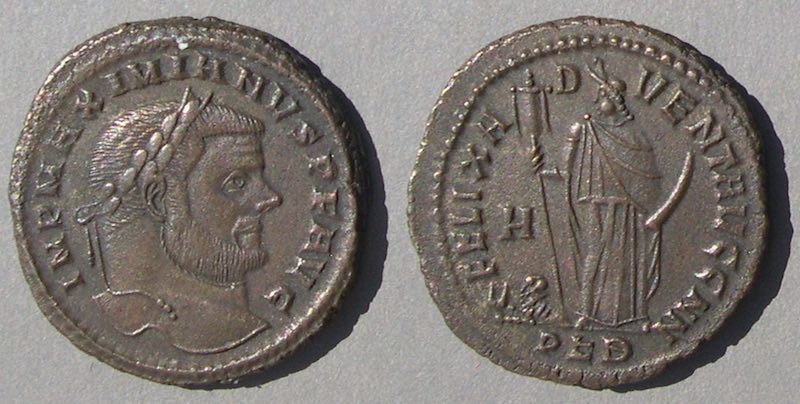 Maximian
Maximian
28 mm. 9.84 grams.
FELIX ADVENT AVGG NN
(Happy arrival of our emperors)
Carthage standing, with elephant-skin headdress, holding standard and elephant tusk, tiny lion feeding on bull below left.
H
PKB
RIC VI Carthage 25B, struck 298, "wholly peculiar to Carthage" with reference to Maximian's arrival there in 297.
(I have a page on types celebrating arrivals, but it is not devoted to the tetrarchy.)
This page is only an introduction. There is more to learn about coins of the First Tetrarchy, but this is enough for an introductory page. Go to the linked pages listed next to learn more, or, better still, get a copy of RIC VI.
Links to related pages referenced above.
• A page about aureliani of the First Tetrarchy.
• A page about GENIO POPVLI ROMANI folles organized by emperor and organized by mint.
• A page about SACRA MONETA folles organized by mint.
• A page about all the follis types of the First Tetrarchy.
• How to distinguish between Maximian and Galerius
• FORTVNA types of folles
• Coded mintmarks on antoniniani (aureliani) of Diocletian and Maximian
• the post-reform radiate = radiate fraction denomination
• the argenteus denomination
• "fractions"-- rare fractional folles from Trier
• "quarter-follis" denomination, a smaller GENIO POPVLI ROMANI denomination only from Siscia
• retirement issues for Diocletian and Maximian.
• Coins of the Second Tetrarchy.
• Coins after the Second Tetrarchy, 306-324.
• Commemoratives of 306-324.
• GENIO types with different legends.
• Coins of the period from 306-310 when coins were issued for Constantine with the new title "FIL AVG".
• [We don't know for sure the relative values of the denominations. A page on this complicated issue will eventually appear.]
When was the reform? We say the date of the reform is "c. 294," but that is just a useful oversimplification. It did not happen at the same time for all denominations involved and it did not happen at all mints at the the same time. For example, the first issue of nummi (folles) at Heraclea is large and yet includes only the Augusti, which strongly implies that part of the reform began before there were Caesars, that is, before March 293. On the other hand, there is no parallel at the other mints, which suggests they began the reform coinage later. Similarly, the first argentei are from Siscia without the Caesars. Bruun in ANSMN 24 considers the sequence of production of argentei and how it spead from mint to mint. Production of the nummis began before production of the aurelianus ceased, as is clear from all the aureliani of the Caesars. The post-reform radiate denomination was issued only in the east, which proves not all mints worked in concert. (Return to near the top ↩.)
Major references:
RIC V, part II. Roman Imperial Coinage, volume V, part II by Percy H. Webb, 1933.
RIC VI, Roman Imperial Coinage, volume VI, by C. H. V. Sutherland, 1973. Many varieties have been discovered since this book was published, but there is no easy way know more than is in this book. Many collectors use RIC solely to provide identification numbers, but it has far more interesting information than just that, including lots of history and chronology with relevant coin evidence.
Failmezger, Victor. Roman Bronze Coins from Paganism to Christianity, 294-364 A.D. 2002. A complete list of types (but not mints, varieties, and RIC numbers) from the coin reform to 364, with very many color photos and short outlines of the history, with chapters on collectible types like the "fallen horseman" coins of the coin reform of 348. I love this book and use it to keep track of types.
Zschucke, Carl-Friedrich. Die Bronze-Teilstück-Prägungen der römischen Münzstätte Trier. 1989. Small paperback. 65 pages with over 200 fractions illustrated.
Continue with a page on coins of the Second Tetrarchy, 305-306.
There is a page of links to other pages on coins of the tetrarchies,
Go to the main Table of Contents page of this whole educational site.